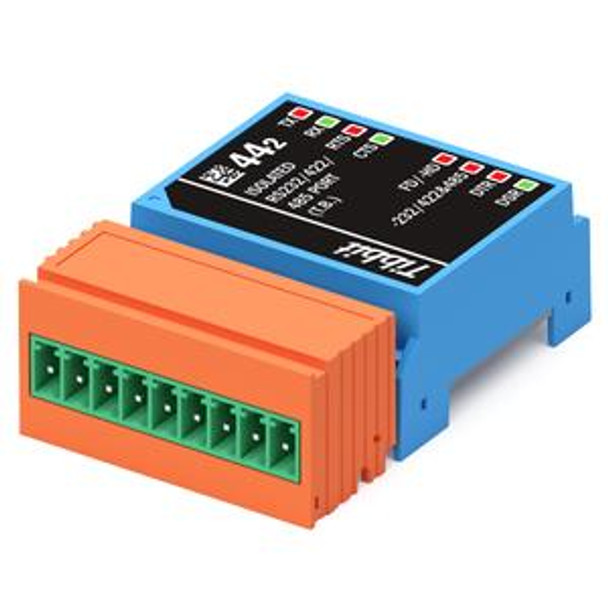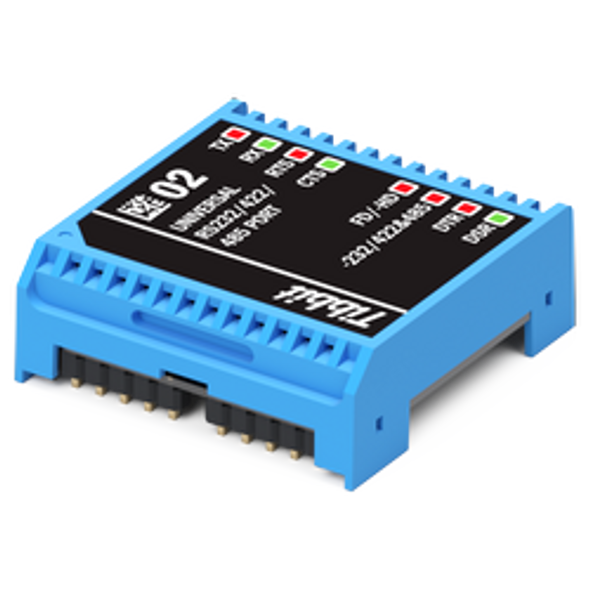Tibbo
Isolated RS232/422/485 port with terminal block
- SKU:
- TIB-44-2
- MPN:
- #44-2
- Availability:
- Usually ships within 24 hours
Description
Form: H2
Power: 5V - Consumes 80mA
Details
This is a "full" serial port that can be electronically configured to work in RS232, RS422, or RS485 mode. The Tibbit is based on the Sipex SP337 universal transceiver.
Galvanic isolation is achieved by using ISO7141 and ISOW7842 digital isolators manufactured by Texas Instruments (ISOW7842 also generates isolated power). These isolators create a separate power domain containing the SP337 transceiver, surrounding circuitry (not shown on the diagram), and the DB9 connector.
Due to the isolation, the ground pin (pin 5) of the DB9M is not connected to the system (CPU) ground and exposes the ground of the isolated domain instead. All I/O lines on the DB9M connector are also from this isolated domain. The need to route an isolated ground to the outside world is why this Tibbit is implemented as a hybrid (H2) and not just a module (M2), as is the case with the non-isolated RS232/422/485 Tibbit #02.
The theoretical isolation between the system power domain and the isolated power domain of this Tibbit is large enough to withstand typical ESD events. The isolation also protects against small ground potential differences that may eventually cause equipment failures.
Communications modes
RS232, RS422, or RS485 mode selection is through FD/HD and 232/422-485 control lines:
| Mode | FD/-HD | -232/422-485 |
| RS232 | HIGH | LOW |
| RS422 | HIGH | HIGH |
| RS485 | LOW | HIGH |
When left unconnected, FD/-HD defaults to HIGH, while -232/422-485 defaults to LOW. This means that the RS232 mode will be selected by default.
In the RS232 mode, the port has RX, TX, RTS, CTS, DTR, and DSR signals. This is a full-duplex mode.
In the RS422 mode, the port has +/-RX, +/-TX, +/-RTS, and +/-CTS signal pairs. This is a full-duplex mode.
In the RS485 mode, the port has only +/-RX and +/-TX signal pairs. This is a half-duplex mode, so you can connect +RX to +TX, and -RX to -TX. This will allow your system to communicate over a single (twisted) wire pair. Direction control is through the RTS line — the line will be LOW for data input and HIGH for output.
For "normal" RS232/422/485 applications, this Tibbit has to be connected to the TX and RX lines of the CPU's UART (see [SER]). Planning to use RTS/CTS flow control as well? An interrupt line must be available, too (see [INT]).
Terminal block connector
Tibbit #44-2 is a hybrid device integrating a terminal block connector. Connector pin assignment is as follows:
| RS232 | RS422 | RS485 | |
| #1 | Isolated TX (output) | Isolated TX+ (output) | Isolated TX+ (output) |
| #2 | Isolated RX (input) | Isolated RX- (input) | Isolated RX- (input) |
| #3 | Isolated RTS (output) | Isolated RTS+ (output) | No connection |
| #4 | Isolated CTS (input) | Isolated CTS+ (input) | No Connection |
| #5 | Isolated Ground | Isolated Ground | Isolated Ground |
| #6 | Isolated DTR (output) | Isolated TX- (output) | Isolated TX- (output) |
| #7 | Isolated DSR (input) | Isolated RX+ (input) | Isolated RX+ (input) |
| #8 | No connection | Isolated RTS- (output) | No connection |
| #9 | No connection | Isolated CTS- (input) | No connection |
LEDs
There are eight LEDs: five red and three green. Red LEDs are connected to TX, RTS, DTR, FD/-HD, and -232/422-485 lines. Green LEDs are for RX, CTS, and DSR.
All LEDs are buffered (with logic gates) and light up for the LOW state of corresponding control lines.






